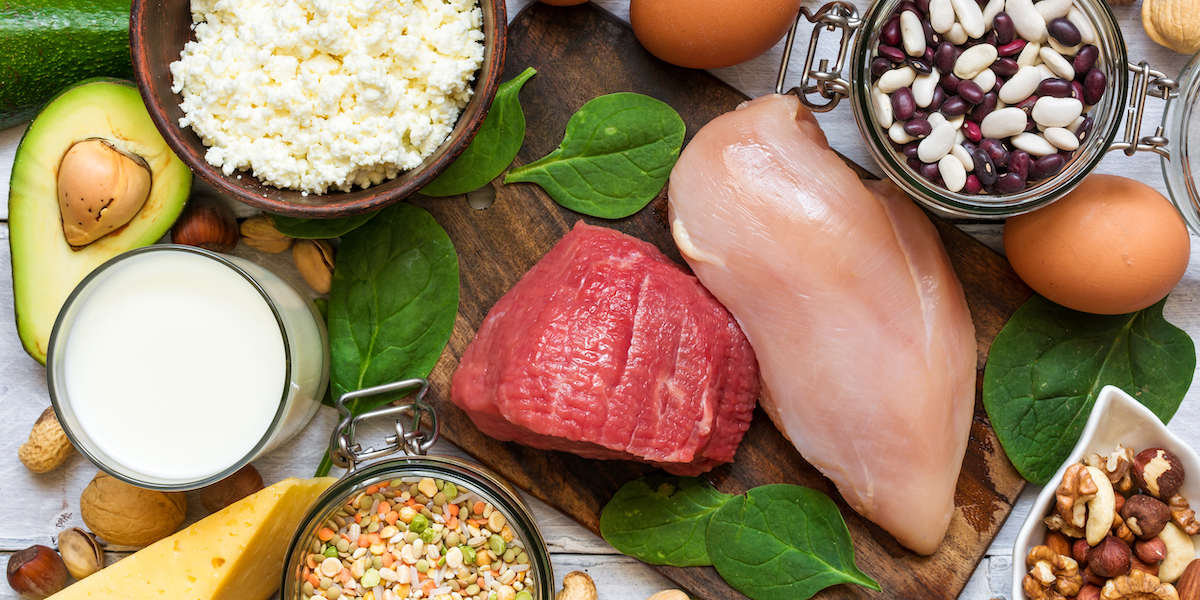Between trendy paleo, keto, and low-carb diets, and headlines consistently spouting the many wonders and benefits of protein, this macronutrient is having a moment — and it doesn’t appear to be leaving the limelight anytime soon.
According to Nielsen data, 55 percent of households say protein is something they take into consideration when shopping for food. This, in combination with the growing popularity of plant-based diets, has spurred the demand for alternative sources of protein, a category that now tops $22 billion annually.
Some people swear by high-protein diets, believing this nutrient reigns supreme, while others think it’s overrated and over-consumed. Protein is often found at the center of our plates, whether we’re meat eaters or vegetarians. But what is protein, exactly? What are the best sources? Is there a magic number we should aim for?
This guide will explain everything you need to know about protein.
What Is Protein?
“Protein is one of the three main macronutrients, which means we require it in large amounts,” says Caitlin Self, MS, CNS, LDN of Frugal Nutrition. “Protein is made up of various amino acids, which are the building blocks for cells, collagen, and critical enzymes. We need protein in order to build muscles, bones, skin, and collagen, for hormones and enzymes, and for basic tissue repair.”
Proteins roles in the body include:
- Repairing body tissues including muscles (like after a tough workout)
- Helping you break down and digest food
- Assisting with normal growth and development
The protein found in foods like chicken, eggs, and tofu is made up of amino acids. Your body makes 11 different amino acids, but we need to get nine more of them (histidine, isoleucine, leucine, lysine, methionine, phenylalanine, threonine, tryptophan, and valine, known as the essential amino acids) from food.
Daily Protein Intake
Here’s the million-dollar protein question: What is the ideal daily protein intake? It actually depends. “The intake of protein for Americans is really varied,” says Self, who commonly sees people going to the extremes on both ends.
The acceptable protein range for adults is 10 to 35 percent of calories. If you eat 1,500 calories a day, that’s between 38 and 131 grams of protein (one gram of protein is four calories).
Another way to look at it: Over the course of a day, you need a minimum of 0.8 grams of protein per kilogram of body weight. If you’re physically active, the number can be higher at 1.4 to 2 grams of protein per kilogram of body weight, depending on how much you’re working out. Don’t forget: In order to figure out how many kilograms you weigh, simply divide your weight in pounds by 2.2 and that will be your weight in kilograms.
While those numbers might seem daunting, remember that’s your daily goal. If you aim to eat around 25-30 grams of protein (or more, depending on your size) at your main meals along with protein in between when you snack, you should have no trouble meeting your needs.
Daily Reference Intakes: The Dietary Reference Intakes for protein (the minimum amount you need to stay healthy) are 56 grams for men ages 19 to 70 and 46 grams for women ages 19 to 70.
“Keep in mind that pregnant and nursing mothers, growing children and adolescents, and highly active athletes will need more protein,” adds Self. (Such groups should aim for the higher end of the range.)
Tempted to go even higher with your protein intake? Don’t do it.
“Consuming too much protein can be really taxing on our kidneys since that’s where it all gets processed,” says Self.
The Best Sources of Protein
There are plenty of protein sources out there — most foods contain a mixture of two or three of the three main macronutrients: carbohydrates, fat, and protein. Even a cup of kale contains some protein (about 0.6 grams).
Although meat and other animal products have the highest-quality protein, “there are smaller amounts of protein available in nuts, seeds, vegetables, and legumes,” says Self.
Here’s an alphabetical list of some of the best sources of protein:
1. Beans and legumes
Legumes are a go-to source of protein for vegetarians and plant-based eaters. Try a variety, from fava beans (almost 13 grams per cup) to lentils (almost 18 grams per cup) and peanuts (technically not a nut, with over 7 grams per ounce) to black beans (almost 15 grams per cup).
2. Buckwheat
Like quinoa, this gluten-free “grain” is technically a pseudocereal. Whatever you call buckwheat, it’s also packed with protein. A cup of cooked buckwheat groats provides nearly 6 grams, and so does a cup of soba noodles (made with buckwheat flour).
3. Chicken and other poultry

Easy to cook and readily available, chicken is a versatile source of protein. Chicken breasts contain 21 grams of protein per 3 ounces, cooked, while chicken thighs contain only slightly less. White meat poultry, such as chicken and turkey breast, without the skin, is the healthiest way to eat this type of protein.
4. Dairy products

The best sources of protein in the dairy aisle are low-fat Greek yogurt (over 24 grams per cup), low-fat cottage cheese (28 grams per cup), and skim milk (about 8 grams per cup). Cheese also provides plenty of protein but also more fat, chiefly saturated fat.
5. Eggs
A whole large egg contains more than 6 grams of protein. Keep the added fat to a minimum during the cooking process, e.g., don’t add cheese, cook on a nonstick skillet with cooking spray, or try hard-boiling or poaching the eggs.
6. Lean beef and pork
Lean beef (95%) contains almost 22 grams of protein in 3 ounces cooked, as does lean pork tenderloin (fat trimmed).
7. Nuts and seeds
From almonds (almost 6 grams) to cashews (more than 4 grams) and walnuts (more than 4 grams) to hulled sunflower seeds (almost 6 grams), a one-ounce serving of nuts and/or seeds offers a portable way to sneak in some protein.
8. Protein powders
Protein shakes can be a super convenient way to up your protein intake. If you want to keep it simple, all you need to do is combine the powder with some water! Just make sure that you pick a high-quality powder without any unnecessary, unhealthy ingredients.
Shakeology will give you 17 grams of whey protein or 16 grams of plant-based protein without any artificial flavors, colors, or preservatives. It also serves up 6 grams of fiber to help you stay fuller for longer.
9. Quinoa

Quinoa is a nearly complete plant-based protein, providing over 8 grams per cup, cooked.
10. Seafood
Salmon provides 19 grams of protein per 3-ounce serving, while the same serving of shrimp offers 20 grams.
11. Tofu and tempeh

Soybeans are a complete plant protein. You’ll get 11 grams in 3 ounces of tofu and 16 grams from the same amount of tempeh.
Personalize to your liking
“The best sources of protein are the ones you tolerate best,” says Self. So, if chicken sits well with you, that’s a great choice. (She recommends pastured poultry if it’s available.) But if black beans “make you feel great, then that’s a good protein source,” she says. (She suggests soaking them first, to make them easier to digest.)
“Our bodies are all different,” she says.
Different Types of Protein
Here are two different ways proteins might be identified:
Complete proteins
One indicator of a good source of protein versus others that are only so-so is the number and levels of various amino acids they contain. Proteins are “complete” if they contain all nine essential amino acids (the building blocks of protein) in sufficient amounts.
While all animal proteins contain all of these essential amino acids, soy is considered the only complete plant protein. But don’t get too hung up on complete versus incomplete. If you follow a plant-based diet, aim to eat a variety of different protein sources to help ensure you’re getting all of the various essential amino acids.
Lean proteins
It’s up to you whether you want to get your protein from meat, poultry, seafood, eggs, dairy, nuts, seeds, beans, and/or legumes. One factor to keep in mind is the amount of saturated fat found in the protein foods you’re eating. Some cuts of red meat or other animal proteins can be high in saturated fat. Lean proteins are your best bet for overall health.
Protein & Weight Maintenance
Protein may be helpful when it comes to appetite regulation because protein consumption is associated with helping you feel fuller longer.
Symptoms of Protein Deficiency
“True protein deficiency is rare,” says Self. That “deficiency typically shows as ascites, which is the buildup of fluid in the abdomen, and muscle atrophy.”
But if you’re consistently coming up short on protein over a long period of time, you may want to check with your healthcare provider. Some possible symptoms of protein deficiency might manifest in some of the ways listed below. But again, it’s always best to consult with a healthcare professional if you have any concerns about your protein intake.
Potential symptoms include:
- Hair loss or dry and dull hair
- Soft and brittle nails
- Brown and patchy pigmentation of the skin
- Impaired wound healing
- Low energy
- Muscle weakness












